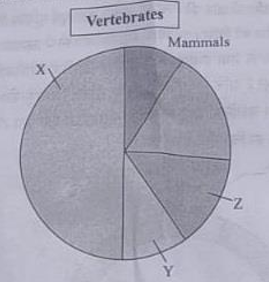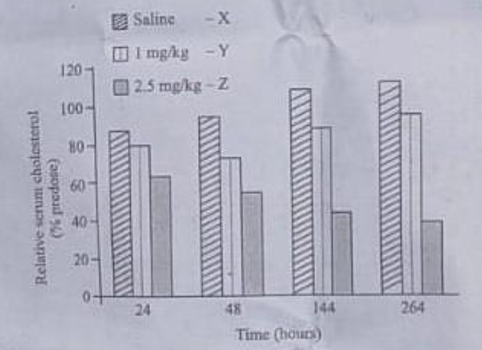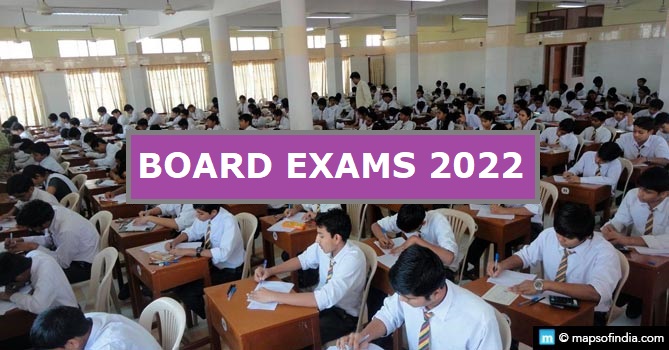The CBSE class 12 Biology exam concluded today at 12:30 pm, with students coming from out centres and stating that it was moderate.
The questions were set as per the syllabus. According to some, other questions were a bit difficult to answer. It had three sets: Section A, Section B and C.
Many felt that the question paper was easier than term – 1 and completed the exam timely. Experts believe that students would be able to score well.
Biology (Class 12) Term 2 Question Paper 2022
SECTION A
I. Ringworm is one of the most common infectious fungal disease in humans. Name any two genera of fungi which cause ringworm and state any of its two symptoms.
Ans. Ringworm is a common infection of the skin and nails that are caused by fungus. The infection is called “ringworm” because it can cause an itchy, red, circular rash. Ringworm is also called “tinea” or “dermatophytosis.”
Trichophyton, Microsporum, and Epidermophyton are fungi that can cause ringworm.
The symptoms include
A scaly ring-shaped area, typically on the buttocks, trunk, arms and legs.
Itchiness.
A clear or scaly area inside the ring, perhaps with a scattering of bumps whose colour ranges from red on white skin to reddish, purplish, brown or grey on black and brown skin.
2. Can we use slurry of human excreta instead of cowdung slurry to produce biogas in a typical biogas plant? Support your answer giving reasons.
Ans. For biogas creation, all organic waste streams can be fed. But humans simply produce not so much waste per person. One cow can produce enough waste to create biogas for 1.5 hours of cooking per day, while the waste of one human will produces biogas for only 2 to 3 minutes per day. This is why using the human slurry is useless.
3. (a) State the mode of cocain on human body. Write the scientific name of the source plant it is obtained from.
Ans. The brain’s mesolimbic dopamine system, its reward pathway, is stimulated by Cocaine. This pathway originates in a region of the midbrain called the ventral tegmental area and extends to the nucleus accumbens, one of the brain’s key reward areas. Besides reward, this circuit also regulates emotions and motivation.
Cocaine acts by binding to the dopamine transporter, blocking the removal of dopamine from the synapse. Dopamine then accumulates in the synapse to produce an amplified signal to the receiving neurons. This is what causes the euphoria commonly experienced immediately after taking the drug.
Cocaine is a white crystalline alkaloid that is obtained from the leaves of the coca plant, Erythroxylum coca.
OR
(b) Enumerate four most common warning signs of drug and alcohol abuse amongst the youth.
Ans. Alcohol and drug abuse in youngsters cause the following:
Losing interest in activities they once enjoyed
Dropping old friends for a new group
Acting despondent, aggressive or angry
Sleeping more than usual
Breaking rules
Exhibiting physical changes like sudden weight loss, frequent nosebleeds, bloody or watery eyes, or shakes and tremors
4. study the given diagram of Sewage Treatment Plant (S.T.P.) and answer the questions that follow :

(a) Winch one of the two ‘S.T.P.’ (A) or (B) will be more effective in treating the human excreta in the municipal waste?
(b) Write the steps followed in carrying the treatment of the sewage in step (Z), once the BOD of sewage is reduced significantly till it is passed on to the “anaerobic sludge digesters”.
5. Write the best method to measure the population density of a single Banyan tree in comparison to 20 Parthenium weeds in a forest by an ecologist. Explain and justify your answer.
Ans. The per cent cover or biomass is a more appropriate measure of the population size, e.g. 20 Parthenium plants and a single huge banyan tree. In this case, the banyan tree produces much more biomass.
6. (a) (i) Write the observation made at the end of Connell’s field experiment on barnacles on the rocky sea coasts of Scotland.
(ii) Name any two categories of organisms that in general are adversely affected by competition
OR
(b) The graphs (X) and (Y) given below depict the diurnal variations in the solar radiations in the month of June (Summer) and in December (Winters) :
SECTION B
7. ‘An HIV patient normally doesn’t die of ‘AIDS’, but death is caused due to many other infections’ Do you agree with the statement ? Give explanatory reasons in support of your answer.
Ans. HIV infection weakens your immune system, making you much more likely to develop many infections and certain types of cancers.
Infections common to HIV/AIDS
Pneumocystis pneumonia (PCP). This fungal infection can cause severe illness. Although it’s declined significantly with current treatments for HIV/AIDS, in the U.S., PCP is still the most common cause of pneumonia in people infected with HIV.
Candidiasis (thrush). Candidiasis is a common HIV-related infection. It causes inflammation and a thick, white coating on your mouth, tongue, oesophagus or vagina.
Tuberculosis (TB). TB is a common opportunistic infection associated with HIV. Worldwide, TB is a leading cause of death among people with AIDS. It’s less common in the U.S. thanks to the wide use of HIV medications.
Cytomegalovirus. This common herpes virus is transmitted in body fluids such as saliva, blood, urine, semen and breast milk. A healthy immune system inactivates the virus, and it remains dormant in your body. If your immune system weakens, the virus resurfaces — causing damage to your eyes, digestive tract, lungs or other organs.
Cryptococcal meningitis. Meningitis is an inflammation of the membranes and fluid surrounding your brain and spinal cord (meninges). Cryptococcal meningitis is a common central nervous system infection associated with HIV, caused by a fungus found in soil.
8. (a) Why do doctors have to carry runny tests for selecting a person to be a suitable donor for someone who is going for an organ transplant and not take the organ from just anybody ? Explain giving reason.
Ans. Transplantation is the replacement of a diseased organ or tissue of an individual with a healthy organ or tissue of the same or another individual. These transplants or graft gets rejected if it is recognized as foreign antigen by the body’s immune systems. Cell-mediated immune response, mediated by T-lymphocyte is able to differentiate between self and non-self cells/organs. This type of immune response recognizes the body’s non-cells or other tissue or organs from another individual as a foreign antigen and causes rejection of the graft.
(b) Name the drug a patient who has undergone a successful organ transplant, has to take all his/her life.
Ans. After an organ transplant, you will need to take immunosuppressant (anti-rejection) drugs.
More answers would be uploaded soon on this page. Students, if find an issue in some of the questions of the paper and wish to know answers can reach out to us through the comment box below.
9. A cell free method of amplifying DNA first developed in the mid 1980’s 3 revolutionized the field of biotechnology. Name the method and explain the basic steps of the technique involved.
10. (a) Given below is an equation describing the Species-Area relationship between species richness and area for a wide variety of taxa as angiosperm plants, birds. bats etc.
![]()
(i) Give a graphical representation of the given equation showing Species-Area relationship.
(ii) What does ‘S’ represent in the given equation ?
(iii) What is the value of ‘Z’ (regression coefficient) for frugivorous birds and mammals in the tropical forests of different continents ?
OR
(b) Given below is a ‘pie chart’ representing the global biodiversity : proportionate number of species of major taxa.

(i) Identify (X) and (Y) in the given ‘pie chart’.
(ii) “Extinction of species across taxa are not random.” Which group amongst the vertebrates is more vulnerable to extinction.
(iii) Give one example each of recent extinctions of species in Russia, Mauritius and Australia.
11. (a) How does a gene therapy involving direct modification of the cells, in order to achieve a therapeutic goal is used in the treatment of ADA deficiency ? Explain.
(b) A host cell must be made competent, before it is able to receive an rDNA. Justify.
12. (a) Enlist two criteria that are used to identify a region for maximum 3 protection as ‘Biodiversity hotspots’.
(b) Name any two “hotspot” regions in our country.
13. (a) Cloning of genes. play a very significant role in genetic engineering, helping the transfer of desirable foreign genes into different hosts. The scientists, to make this process easier and effective are creating engineered vectors in such a way that they help easy linking of foreign DNA and selection of recombinants from non recombinants. ‘pBR322’ is one such engineered vectors developed by scientists. A diagram of an engineered vector pBR322 is given below :

(i) Name the host for cloning vector.
(ii) Identify ‘Rop’ and ‘Ori’ in the diagram from ‘U’, ‘V’, ‘W’, ‘X’, ‘Y’ and ‘Z’. Write their functions.
(iii) Draw the fragments that will be formed by the action of ‘Z’ (marked in the diagram) on the specific site of the DNA segment given below :
5′—GTACGAATTCCTGA—3′
3′—CATGCTTAAGGACT—5′
OR
(b) RNA interference (RNAi) holds great potential as a therapeutic agent for the treatment of human diseases and as biocontrol agents in controlling pests in the field of agriculture. An experiment was carried to study the use of ‘RNAi ‘ for the potential treatment of disorders of cholesterol metabolism. Some people possess genetic mutations with elevated levels of ApoB gene which predisposes them to coronary artery diseases.
Lowering the amount of ApoB can reduce the number of lipoproteins and lower the blood cholesterol.
Tracy Zimmerman and her colleagues used RNAi in 2006 to reduce the level of ApoB in non human primates Cynomolgus monkeys.
One group of monkeys were given RNAi treatment (small interfering RNAs, SiRNAs) (doses 1 mg/kg SiRNAs), second group of monkeys were given RNAi treatment (doses 2.5 mg/kg SiRNAs) and third group of monkeys were injected with saline.
The results of the study are depicted in the graph below :

(i) How does the treatment with 2.5 mg/kg brings an effect on cholesterol metabolism when compared from 24 hours and 144 hours.
(ii) Write any two natural sources from where dsRNA molecule could be obtained for silencing the specific mRNA.
(iii) How is RNAi used in controlling the infection on the roots of tobacco plants by the nematode Meloidogync incognitia.




